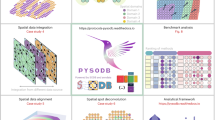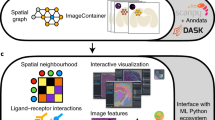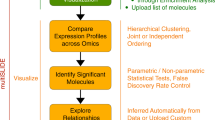Abstract
Data-intensive research depends on tools that manage multidimensional, heterogeneous datasets. We built OME Remote Objects (OMERO), a software platform that enables access to and use of a wide range of biological data. OMERO uses a server-based middleware application to provide a unified interface for images, matrices and tables. OMERO's design and flexibility have enabled its use for light-microscopy, high-content-screening, electron-microscopy and even non-image-genotype data. OMERO is open-source software, available at http://openmicroscopy.org/.
This is a preview of subscription content, access via your institution
Access options
Subscription info for Japanese customers
We have a dedicated website for our Japanese customers. Please go to natureasia.com to subscribe to this journal.
Buy this article
- Purchase on SpringerLink
- Instant access to full article PDF
Prices may be subject to local taxes which are calculated during checkout





Similar content being viewed by others
References
Linkert, M. et al. Metadata matters: access to image data in the real world. J. Cell Biol. 189, 777–782 (2010).
Swedlow, J.R. & Eliceiri, K.W. Open source bioimage informatics for cell biology. Trends Cell Biol. 19, 656–660 (2009).
Goldberg, I.G. et al. The open microscopy environment (OME) data model and XML file: open tools for informatics and quantitative analysis in biological imaging. Genome Biol. 6, R47 (2005).
Swedlow, J.R., Goldberg, I.G. & Eliceiri, K.W. Bioimage informatics for experimental biology. Annu. Rev. Biophys. 38, 327–346 (2009).
Dougherty, M.T. et al. Unifying biological image formats with HDF5. Commun. ACM 52, 42–47 (2009).
Gray, J. et al. Scientific Data Management in the Coming Decade (Microsoft Research, Inc., 2005).
Carpenter, A. et al. CellProfiler: image analysis software for identifying and quantifying cell phenotypes. Genome Biol. 7, R100 (2006).
Lee, K. et al. Visualizing plant development and gene expression in three dimensions using optical projection tomography. Plant Cell 18, 2145–2156 (2006).
Smith, B. et al. The OBO foundry: coordinated evolution of ontologies to support biomedical data integration. Nat. Biotechnol. 25, 1251–1255 (2007).
Kvilekval, K., Fedorov, D., Obara, B., Singh, A. & Manjunath, B.S. Bisque: a platform for bioimage analysis and management. Bioinformatics 26, 544–552 (2010).
Swedlow, J.R., Goldberg, I., Brauner, E. & Sorger, P.K. Informatics and quantitative analysis in biological imaging. Science 300, 100–102 (2003).
Sanna, S. et al. Variants within the immunoregulatory CBLB gene are associated with multiple sclerosis. Nat. Genet. 42, 495–497 (2010).
Browning, S.R. Missing data imputation and haplotype phase inference for genome-wide association studies. Hum. Genet. 124, 439–450 (2008).
Li, Y., Willer, C., Sanna, S. & Abecasis, G. Genotype imputation. Annu. Rev. Genomics Hum. Genet. 10, 387–406 (2009).
Hill, E. Announcing the JCB DataViewer, a browser-based application for viewing original image files. J. Cell Biol. 183, 969–970 (2008).
Lawson, C.L. et al. EMDataBank.org: unified data resource for CryoEM. Nucleic Acids Res. 39, D456–D464 (2011).
Abramoff, M.D., Magalhaes, P.J. & Ram, S.J. Image processing with ImageJ. Biophotonics International 11, 36–42 (2004).
Yoo, T.S. et al. Engineering and algorithm design for an image processing API: a technical report on ITK—the insight toolkit. in Proceedings of Medicine Meets Virtual Reality (ed., J. Westwood) 586–592 (IOS Press, Amsterdam, 2002).
Rosset, A., Spadola, L., Ratib, O. & Osiri, X. An open-source software for navigating in multidimensional DICOM images. J. Digit. Imaging 17, 205–216 (2004).
Conrad, C. et al. Micropilot: automation of fluorescence microscopy-based imaging for systems biology. Nat. Methods 8, 246–249 (2011).
Acknowledgements
We thank E. Hill for helpful comments on the manuscript. Work on OME, Bio-Formats and OMERO in J.R.S.'s laboratory is supported by the Wellcome Trust (085982 and 095931) and the Biotechnology and Biological Sciences Research Council (BBSRC) (BB/G022585 and BB/I000755). Work on OMERO Electron Microscopy Data Bank at the European Bioinformatics Institute is supported by the BBSRC (BB/G022577). Work on OMERO at the John Innes Center, Norwich is supported by Joint Information Systems Committee (REXDAT03).
Author information
Authors and Affiliations
Corresponding author
Ethics declarations
Competing interests
C.A., J.-M.B., J.M., C.N., M.L. and J.R.S. are affiliated with Glencoe Software, Inc., an open-source US-based commercial company that contributes to OMERO.
Supplementary information
Supplementary Text and Figures
Supplementary Note (PDF 101 kb)
Rights and permissions
About this article
Cite this article
Allan, C., Burel, JM., Moore, J. et al. OMERO: flexible, model-driven data management for experimental biology. Nat Methods 9, 245–253 (2012). https://doi.org/10.1038/nmeth.1896
Published:
Issue Date:
DOI: https://doi.org/10.1038/nmeth.1896
This article is cited by
-
Neuropathological assessment of the olfactory bulb and tract in individuals with COVID-19
Acta Neuropathologica Communications (2024)
-
Engineering of bidirectional, cyanobacteriochrome-based light-inducible dimers (BICYCL)s
Nature Methods (2023)
-
FAIR High Content Screening in Bioimaging
Scientific Data (2023)
-
Building a FAIR image data ecosystem for microscopy communities
Histochemistry and Cell Biology (2023)
-
A data management infrastructure for the integration of imaging and omics data in life sciences
BMC Bioinformatics (2022)



